Facelift – page to remove


Injectables and fillers can help put the brakes on facial aging, but they are not substitutes for a traditional facelift (rhytidectomy). Similarly, a stem cell facelift uses fat injections to add volume to the aging face, but it does not provide the lift that a surgical facelift does. Unlike either of these nonsurgical options, which have limited staying power, surgical facelifts last more than 10 years. That said, facelift — which is used to treat severe facial skin laxity and sagging — is a major surgical procedure that requires considerable healing time.
There are five basic components of an aging face:
- Fine lines and wrinkles
- Skin pigment changes such as age spots
- Loss of volume such as hollow cheeks
- Loss of elasticity
- Gravity

Fine lines, wrinkles and age spots may improve with skin resurfacing techniques, such as laser skin resurfacing, chemical peels or microdermabrasion. Wrinkles may further improve with the use of injectables such as collagen or Botox. Loss of volume and folds, including nasolabial folds, may be treated with injectables such as Restylane and Juvederm. (Also called laugh lines, nasolabial folds are the deep folds which run from the side of the nose to the corner of the mouth.) The loss of elasticity and the effects of gravity on the face, however, can be improved only with traditional facelifts.
Are you a candidate for a facelift? You may be if your facial skin is loose and sagging, particularly along the jaw line or under the chin. People with a strong jaw line or well-defined bone structure are also good candidates for a facelift.
A facelift can correct many things to improve appearance, including:
- Sagging in the midface
- Deep creases below the lower eyelids
- Deep creases along the nose extending to the corner of the mouth
- Fat that has fallen or is displaced
- Loose skin and excess fatty deposits under the chin and jaw that can make even a person of normal weight appear to have a double chin
Preparing for Facelift Surgery

A consultation is the first step toward your new, improved face. This evaluation will determine if you are a good candidate for a facelift. Your surgeon will take a thorough medical history. He or she will evaluate your skin’s elasticity, bone structure, wrinkles and folds, as well as your hairline, to better guide incision placement. Your expectations concerning the facelift will also be discussed, and the surgeon will likely take some “before” photos.
Once you have decided to have a facelift, chosen a surgeon and booked your procedure, your doctor will give you a list of pre-operative instructions.
In the two weeks before your facelift, your plastic surgeon will likely suggest that you stop taking certain medications, including aspirin, non-steroidal anti-inflammatory drugs (NSAIDs) and blood thinners, all of which can increase bleeding risk. Certain herbal remedies may also increase bleeding risk. Just because a product or preparation is “all-natural” does not mean it is safe. For example, vitamin E, omega-3 fatty acids, green tea and gingko biloba all may increase bleeding risk during and after facelift surgery.
Make sure you tell your surgeon about EVERYTHING that you are taking. Never stop taking any medication abruptly without first speaking to your doctor.
Schedule a “brown-bag check-up” with your surgeon before your facelift surgery. A brown-bag check-up is when you gather all of your current medications and over-the-counter products into a “brown-bag” and show them to your doctor so he/she can look for any potential problems before they occur.
Some plastic surgeons may also suggest adding medications to your daily regimen in the weeks leading up to your facelift. The herb arnica and the enzyme bromelain, for example, may help minimize bruising and swelling after a facelift.
The pre-op instructions will also include a list of do’s and don’ts about eating and drinking before your facelift.
Quitting smoking before your facelift is a must. Most surgeons recommend that prospective patients kick the habit for the month before and the month after the facelift. Smoking reduces blood flow to areas of the face. As a result, one in 10 smokers will experience skin death (necrosis) at the incision sites if they continue to smoke before and after surgery. Wounds may turn red and black, and the edges may start coming apart. Such wounds may require a skin graft, another surgery in which a patch of skin is surgically removed from one area of the body and transplanted to another area.
Many tools are available today to help smokers become ex-smokers. (See sidebar.)
Nicotine replacement products, such as nicotine patches, nicotine gum and nicotine lozenges, are available over-the-counter. A nicotine nasal spray and inhaler are currently available by prescription. These can help relieve nicotine withdrawal symptoms.
But keep in mind that nicotine patches and other nicotine replacement systems can’t be used as smoking cessation aids immediately before or during surgery. They cause some of the same problems with wound healing as cigarette smoking. Tell your surgeon if you are using any nicotine replacement products.
Drugs such as buproprion SR (Zyban) and varenicline tartrate (Chantix) are non-nicotine pills that may help you quit smoking before a facelift. Talk to your doctor about a prescription.
Also, hypnotherapy or acupuncture may help some people quit smoking. Acupuncture involves placing extremely thin needles into the skin along specific acupuncture points to help curb the desire to smoke.
Quit Smoking Now: Here’s How
Nicotine replacement products, such as nicotine patches, nicotine gum and nicotine lozenges, are available over the counter. A nicotine nasal spray and inhaler are currently available by prescription. These can help relieve nicotine withdrawal symptoms.
But keep in mind that nicotine patches and other nicotine replacement systems can’t be used as smoking cessation aids immediately before or during surgery. They cause some of the same problems with wound healing as cigarette smoking. Tell your surgeon if you are using any nicotine replacement products.
Drugs such as buproprion SR (Zyban) and varenicline tartrate (Chantix) are non-nicotine pills that may help you quit smoking before a facelift. Talk to your doctor about a prescription.
Also, hypnotherapy or acupuncture may help some people quit smoking. Acupuncture involves placing extremely thin needles into the skin along specific acupuncture points to help curb the desire to smoke.
The Facelift Procedure
Despite their variations, most facelift procedures share certain elements. First, you will be provided with either general anesthesia, local anesthesia or conscious sedation, in which you are numb but partially awake.
Your surgeon then will create incisions along your hairline and around your ears, possibly extending into your scalp. Your surgeon then will lift your skin away from your face, rearrange the underlying tissue in a higher position and remove excess skin. He or she may also remove fat with liposuction. Lastly, your surgeon will re-drape your skin over your face and close the incisions with sutures.
Male Facelift Surgery
Facelift is typically thought of as a procedure for women. However, male facelift surgery is fairly common, with men making up about 9 percent of facelift patients, according to the American Society of Plastic Surgeons.
While some men may fear that a facelift will make them appear more feminine, this is not the case. A skilled plastic surgeon can enhance rather than minimize the masculine features of a man’s face.
Facelift Combos and Alternatives
A facelift can produce remarkable results. However, the procedure only targets certain parts of the face — namely, the mid-face, lower face and jawline. You may find that other areas of your face require attention in addition to or instead of those areas that can be addressed with facelift. In this case, your surgeon may recommend additional or alternative procedures.
- Neck lifts are often combined with facelifts. These procedures are used to remove fat and excess skin to eliminate wrinkles and bands and create a smoother, tighter neck appearance.
- Eyelid surgery is performed to address droopy upper eyelids and puffy lower eyelids, which can cause you to appear older and more tired than you feel.
- Brow lift (forehead lift) can reduce the appearance of droopy eyebrows and deep furrows and creases on the forehead.
- Facial implants are made of silicone and can be placed in your chin, cheek or jaw to improve your overall facial symmetry and proportion.
- Chin surgery may involve reducing the size of the chin by removing bone or enlarging the chin with implants.
- Rhinoplasty (nose reshaping surgery) can help bring your nose into better proportion with your face by making it larger or smaller. Your surgeon can also remove a hump from your nose or a dip from the bridge of your nose, or otherwise improve your nasal profile.
- Otoplasty (ear surgery) is performed to reduce the appearance of excessively protrusive ears. This is one of the few plastic surgery procedures most often performed on young children.
Less Invasive Facial Procedures
For signs of facial aging not yet severe enough for facelift, surgeons often recommend less invasive procedures, such as thread lifts. When performing a thread lift, your surgeon makes small incisions and uses a threaded needle to provide lift to your face. For more information on this procedure, please visit our thread lift discussion page.
Thermage, another less invasive procedure, involves the use of radiofrequency energy. When applied to the skin, the radiofrequency energy heats the skin’s collagen, tightening the existing collagen and stimulating the production of new collagen, the result of which produces smoother-appearing skin.
Other treatments that can be used in combination with — or instead of — facelift include facial injectables and fillers. Facial injectables include Botox, Dysport and Xeomin, which paralyze wrinkle-producing muscles. Fillers such as Juvederm and Restylane can add volume to sunken cheeks and minimize facial folds. However, these treatments provide temporary results and cannot address severe sagging and jowls the way that facelift can.
Stem cell facelift is another alternative treatment. Despite its name, a stem-cell facelift is not a facelift. When performing this procedure, your surgeon will remove fat cells from somewhere in your body, process them to activate the stem cells, and re-inject them into your face to add volume and generate new skin cells.
Superficial skin care treatments like laser skin resurfacing, microdermabrasion and laser hair removal can also address many of the visible signs of aging in the face, such as fine lines, acne scars and discoloration. But like injectables and fillers, they cannot treat major sagging and provide only temporary results.
The Evolution of the Facelift
Over the years, the facelift procedure has evolved from a simple skin lift to the more complex deeper plane lift. There are many types of facelifts. You should ask your doctor about facelift variations, which include the deep plane lift, the superficial musculoaponeurotic system (SMAS) facelift, the endoscopic facelift, and the short scar facelift. Whereas facelift is often viewed to be a feminine procedure, the growth of male plastic surgery has fueled an associated growth in male facelift procedures. Although essentially the same surgery, there are a few key differences.
Regardless of the type of facelift you and your surgeon decide on, many of the key steps are the same:
Anesthesia. Normally a facelift is performed with a combination of mild sedatives, local anesthesia and a mild intravenous anesthesia. Some less extensive facelifts can be performed using only local anesthesia. Occasionally, a facelift may be performed under general anesthesia.
Incision. The facelift procedure usually involves incisions in front of and behind the ear. The incisions may extend into the scalp. In all cases, the incision is placed where it will fall in a natural crease of the skin for camouflage. Some surgeons may suggest that you grow your hair longer if it is currently very short, because longer locks will hide incisions during healing. In men, the incision is aligned to accommodate the natural beard lines.

The facelift. Once the incisions are made, various degrees of undermining of the skin are performed, and the deeper layers of the face are “lifted.” Excess skin is removed, and some fat may be removed with liposuction. In other cases, the skin and muscle tissues are reshaped. The underlying muscle may be tightened with the skin, or separately. After the tightening or removal of excess skin, the skin is re-draped and sutured or stapled in place.
Following the surgery, your surgeon will apply a dressing to protect the entire area where the incisions have been made.
TIP: Brown bag it.
Prior to your facelift surgery, schedule a “brown-bag check-up” with your surgeon. This involves gathering all the current prescription medications, over-the-counter products, vitamins and supplements to show to your doctor. He or she will let you know if any of them present a potential problem for your surgery or recovery.
Stem Cell Facelift
One of the newest buzz terms to surface in plastic surgery is “stem cell facelift,” and it’s creating a lot of interest as well as confusion. In a nutshell, the procedure involves the harvesting and manipulation of adipose (fat) stem cells, which are then injected into key areas of the face to create a rejuvenated look. Major professional organizations in the field of cosmetic plastic surgery — the American Society for Aesthetic Plastic Surgery (ASAPS) and the American Society of Plastic Surgeons (ASPS) — state that there is tremendous potential for use of stem cells in cosmetic surgery, but as of now there is not enough evidence to substantiate any of the current marketing claims.
What Is a Stem Cell Facelift?

Simply put, the stem cell facelift isn’t really a facelift — and it’s not just about stem cells, either.
As we age, our tissues sag and we lose volume all over, but this loss is especially noticeable in the face. Traditional facelifts involve surgical incisions and the lifting of skin and connective tissues to smooth away loose and sagging skin. The procedure does a great job of repositioning tissues, but it doesn’t replace volume. Fat grafting adds volume, but doesn’t lift anything. That’s why many, if not most, facelifts done today include fat grafting as part of the procedure.
Fat injections are not new. Doctors have been using them for years to rejuvenate other body parts, including the hands and neck and, more recently, for fat transfer breast augmentation. Fat adds volume — and while you may not want that extra fullness around your hips and thighs, you might need it in your face as it starts to lose volume due to aging.
So what’s different about a stem cell facelift? In these procedures, physicians take the harvested fat and concentrate and/or manipulate the stem cells prior to injection. Once injected, advocates claim, the stem cells work magic. Proponents also insist that the risk of facelift complications is lower with the new procedure than with traditional facelift surgery.
Stem Cell Facelift: The Procedure
The first step in a stem cell facelift is the harvesting of the fat cells, which is accomplished through a gentle procedure similar to liposuction. The amount of fat removed from donor sites for a stem cell facelift is generally not enough to make much of a difference in the appearance of those areas.
After the fat cells are gently suctioned out of the donor sites on the body, the stem cells are processed using a special device or “activated” via drugs, chemicals, or lasers. It’s important to note that the stem cells found in fat cells are not the embryonic stem cells we’ve heard so much about at the political level. Adult stem cells are the building blocks for all cells in the human body, including fat cells.
After processing, the stem cells are injected along with fat cells into the facial areas where fullness is desired. No devices for concentrating stem cells are currently approved by the Food and Drug Administration, nor is there sufficient clinical data regarding the safety and efficacy of these methods.
Stem Cell Facelift Cost and Risks
Stem cell facelifts cost between $5,500 and $15,000. This is significantly more expensive than fat grafting alone.
As with any surgery, there are risks associated with a stem cell facelift. They include lumps or bumps of injected fat, contour deformities at the donor site, and a general dissatisfaction with the aesthetic results.
Traditional Options
For those who are still wary of the promise of stem cell facelifts, other, more established facial rejuvenation procedures are available. Among the possibilities are soft tissue fillers like Sculptra and Juvederm, brow lift, lip augmentation and cheek augmentation. Consult with a board-certified plastic surgeon to learn more about your options. Start your search for a qualified surgeon now.
About the Reviewer of This Article
Darrick E. Antell, MD, is an educational spokesperson for the American Society of Plastic Surgeons. He is a board-certified plastic and reconstructive surgeon who has been in private practice for more than 20 years in New York City. Dr. Antell is a member of the American Society for Aesthetic Plastic Surgery and the American Society of Plastic Surgeons. He is also a Fellow of the American College of Surgeons. Dr. Antell received his general surgery training at Stanford University Medical Center and his specialty training in plastic/reconstructive surgery at the New York Hospital/Cornell Medical Center and the Memorial Sloan-Kettering Cancer Center in New York City.


